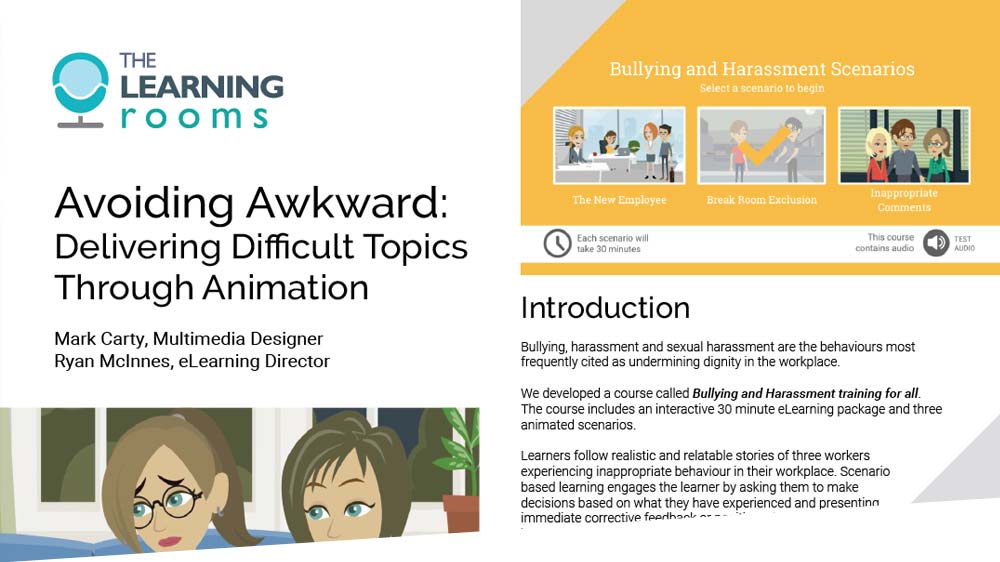
12 Nov Avoiding Awkward: Delivering Difficult Topics Through Animation
The Learning Rooms presented two posters at the 28th ICDE World Conference on Online Learning (WCOL) in the Convention Centre, Dublin, 3-7 November 2019.
- Title: Avoiding Awkward: Delivering Difficult Topics Through Animation
- Presenting author: Mark Carty
- Submitted as: Digital Poster
- Theme: Innovative Learning Designs for Student Success
This poster examines the effectiveness of animation as a driver of learner success in an online bullying and harassment course which blends interactive eLearning content and animated scenarios.
Scenario based eLearning on difficult topics requires multimedia material that presents real life situations in a way that allows the user to be objective rather than emotive in their decision making. The poster takes the positional stance that animation is an effective and efficient method for setting the scene and developing emotive scenarios.
The course runs for the first time Q2 2019. Qualitative analysis of the first cohort will be presented.

Download Avoiding Awkward: Delivering Difficult Topics Through Animation poster as PDF.
Avoiding Awkward: Delivering Difficult Topics Through Animation
Introduction
Bullying, harassment and sexual harassment are the behaviours most frequently cited as undermining dignity in the workplace. We developed a course called Bullying and Harassment training for all. The course includes an interactive 30 minute eLearning package and three animated scenarios. Learners follow realistic and relatable stories of three workers experiencing inappropriate behaviour in their workplace. Scenario based learning engages the learner by asking them to make decisions based on what they have experienced and presenting immediate corrective feedback or positive reinforcement based on their choices.
Animations are a great tool for displaying complex issues and can help learners understand difficult concepts more easily. (Ainsworth, 2008)
Emotion
Emotion plays a central role in this learning experience (Elias & Moceri, 2012). The use of storytelling is designed to evoke empathy from the learner. The scenarios expose the learner to potentially familiar real life workplace situations and experiences which some may find difficult or uncomfortable to watch. Highly stylised animated characters and settings ensure that the simulation remains familiar but different enough from real life to reduce the likelihood of a negative emotional response creating a barrier to learning.
“Our learners found the module engaging and felt that the animations brought the situation to life.” Director of Human Resources, Depaul
Method
This digital learning project was developed using Vyond to create the animations and Articulate Storyline 360 to add interactivity. Vyond is an online video platform that allows us to quickly create animated content using a customisable library of visual assets and templates. We can rapidly design and edit characters and settings before adding animation and voiceover. Vyond gives us the freedom to make changes whenever necessary and make future edits easily. The course was released to a pilot cohort of learners in mid 2019. These learners were spread across a cross-border charity, healthcare organisation and financial services institution.
Results and Conclusion
Analysis of feedback from the first cohort suggests that the course has been well received by both line managers and employees. Learners felt that the course content was practical and true to life and that the interactions were an excellent way to reinforce learning. Notable feedback referred to the animated content as being “reminiscent of childhood” and “comforting.” This is a testament to the effectiveness of animation. It is hoped that the launch of this course within an organisation will improve knowledge of bullying, harassment and sexual harassment as well as triggering and driving behavioural change where required.
“…your message can get muddled with the portrayal of real people… With animated video you can… strike a wider range of emotional tones. This can help cover difficult subjects effectively, without causing your audience to put their defenses up.” (Vyond Team, 2016)
References
- Ainsworth, S. (2008). How do animations influence learning? In D. Robinson & G. Schraw (Eds.), Current Perspectives on Cognition, Learning, and Instruction: Recent Innovations in Educational Technology that Facilitate Student Learning. pp 37-67. Information Age Publishing.
- Elias, M. J., & Moceri, D. C. (2012). Developing social and emotional aspects of learning: the American experience. Research Papers in Education, 27(4), 423-434.
- Vyond Team. (2016). 7 reasons why you should use animated video. Retrieved from https://www.vyond.com/resources/7-reasons-why-you-should-use-animated-video.
- Images: The Learning Rooms. (2019). Stills from course Bullying and Harassment training for all [Image].
Acknowledgements
Thanks to The Learning Rooms team for their input and support in the planning and preparation of this poster. Thanks also to our clients for their cooperation and feedback.


